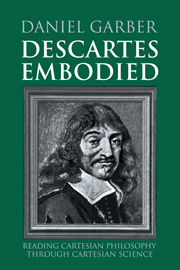Book contents
- Frontmatter
- Contents
- Acknowledgments
- Abbreviations, Citations, and Translations
- Introduction
- Part I Historiographical Preliminaries
- Part II Method, Order, and Certainty
- 2 Descartes and Method in 1637
- 3 A Point of Order: Analysis, Synthesis, and Descartes' Principles (with Lesley Cohen)
- 4 J.-B. Morin and the Second Objections
- 5 Descartes and Experiment in the Discourse and Essays
- 6 Descartes on Knowledge and Certainty: From the Discours to the Principia
- Part III Mind, Body, and the Laws of Nature
- Part IV Larger Visions
- Sources
- Index
4 - J.-B. Morin and the Second Objections
Published online by Cambridge University Press: 10 November 2009
- Frontmatter
- Contents
- Acknowledgments
- Abbreviations, Citations, and Translations
- Introduction
- Part I Historiographical Preliminaries
- Part II Method, Order, and Certainty
- 2 Descartes and Method in 1637
- 3 A Point of Order: Analysis, Synthesis, and Descartes' Principles (with Lesley Cohen)
- 4 J.-B. Morin and the Second Objections
- 5 Descartes and Experiment in the Discourse and Essays
- 6 Descartes on Knowledge and Certainty: From the Discours to the Principia
- Part III Mind, Body, and the Laws of Nature
- Part IV Larger Visions
- Sources
- Index
Summary
Of the seven sets of objections to the Meditations, two stand out as being a bit different, the Second and the Sixth. In every other case we can identify one person, a philosopher or a theologian, who is the author of those objections. In the case of the Second and the Sixth, though, we are dealing with objections that have been collected by one person, the ever-present Father Mersenne, but that purport to represent the work of a number of other scholars, who remain unidentified. For most purely philosophical purposes, this does not matter a great deal; after all, an idea is an idea, whoever happens to have it, and if what is important is just the confrontation of ideas with one another, then the particular identity of the authors in question, those who contributed to these two sets of objections, is relatively unimportant.
But for those of us with a more historical approach to the texts, this is an unfortunate gap. First of all, it is intrinsically interesting from an historical point of view to know who may have contributed to the drafting of these objections. But more important, in order to understand the objections, their meaning and import, it is very important to know something about their authors. In particular, I shall argue that, behind the scenes in the Second Objections and Replies, there is not merely an author but a text that is important for understanding what Descartes is doing, a text that is implicitly referred to in the Second Objections and is the direct object of Descartes' reply in the geometrical presentation of the arguments that follows the Second Replies.
- Type
- Chapter
- Information
- Descartes EmbodiedReading Cartesian Philosophy through Cartesian Science, pp. 64 - 84Publisher: Cambridge University PressPrint publication year: 2000

